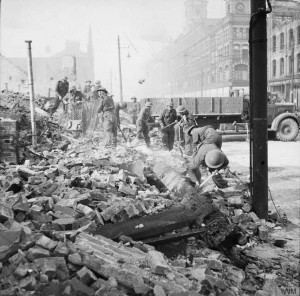A Belfast blitz memorial?
Published in Issue 2 (March/April 2016), News, Volume 2475TH ANNIVERSARY
By Brian Barton

Royal Welch Fusiliers assist in clearing bomb damage in Belfast, 7 May 1941. (IWM)
In his book Post 381, Jimmy Doherty, former air-raid warden, describes the Belfast blitz as being the ‘most disastrous event in the history of the city’. Undoubtedly it was a traumatic and defining one, unprecedented in the history of Ireland. Major cities in Britain experienced many more air raids than Belfast—Liverpool had 74 and Glasgow eleven. Belfast had just four, but two of these were particularly severe. On Easter Tuesday night, 15/16 April 1941, the bombs fell mainly on densely populated working-class terraces in north Belfast, killing 740 civilians. John Blake states in his official history of the war: ‘No other city in the United Kingdom, save London, had lost so many … in one night’s raid. No other city, save, perhaps, Liverpool, ever did.’ On Sunday night, 4/5 May 1941, the city’s industrial heart in the dock area was struck, along with east Belfast and the city centre, and over 190 citizens were killed.
Over 960 civilians died or were declared ‘missing, presumed dead’. Military casualties must be added to these figures. There were 17,000 troops based in the Belfast area at the time, and others were home on leave. On Easter Tuesday night Victoria Barracks was severely bombed, and at Newtownards airport thirteen soldiers were killed when Nissen huts were struck. During the 4/5 May attack thirteen soldiers died when the Military Hospital at Campbell College was hit. Amongst other incidents, two gun emplacements were blown up during the raids, causing casualties. Thus the total number of blitz fatalities is over 1,000. In addition, over half of the city’s housing stock was destroyed or damaged, and half of its public elementary schools. Roughly 50,000 people were left homeless. The impact on civilian morale was dramatic; officials estimated that, by late May 1941, some 220,000 had evacuated from the city (about half of its population), such was the atmosphere of panic and fear.
I was first impelled to write about the blitz because virtually no research had been conducted into it; its details were little known and its traumatic impact had not been fully acknowledged or analysed. And it is still not adequately commemorated. Belfast City Council is currently devising plans, however, to mark its 75th anniversary this year. These include an interdenominational religious service to be held in St Anne’s Cathedral and a public lecture at City Hall. To mark the event more permanently, eighteen sites closely associated with the blitz have been identified, and plaques will be erected at each (e.g. in Hogarth Street and Percy Street, where great loss of life was incurred, and at St George’s Market, Falls Road Leisure Centre and Peter’s Hill Baths, each of which was used as a mortuary).
In recent months a number of parties and individuals (myself included) have also been pressing for the erection of a permanent civic memorial, to be located near the Cenotaph at City Hall, and this is currently under consideration (Belfast’s 31 civil defence blitz casualties are commemorated by a plaque within City Hall). We feel that the memorial should list the names of the c. 900 civilian victims that are known—95% of the total; any persons omitted, along with military personnel who died, could be added later (there are two memorials dedicated to unidentified/ unclaimed civilian blitz victims in Belfast’s City and Milltown cemeteries). The inscribing of the names would help bring home to onlookers the immense loss, and would highlight the fact that in some instances entire families were wiped out. It would personalise the memorial and make future ceremonies held there infinitely more meaningful and poignant, especially for the surviving families. It would fulfil a real need: some of those whose names would be recorded do not have any marked grave at present (i.e. those declared to be ‘missing, presumed dead’ by the city coroner in 1941).
Blitz memorials of this nature have been erected in a number of locations in Britain, and also in Ireland. There is a remembrance garden and a plaque to commemorate the victims of the North Strand bombing in Dublin (30/31 May 1941). Likewise, at Campile, Co. Wexford, an impressive memorial has been erected to mark the death of three local girls killed by a Luftwaffe mine (26 August 1940)—the first fatalities caused by German bombing anywhere in Ireland. Moreover, in the grounds of Belfast City Hall there is a monument dedicated to the victims of the sinking of the Titanic. In the centenary year of the disaster (2012) a remembrance garden was added, beside which the c. 1,500 names of those who perished are inscribed. Fewer than ten of the persons listed were natives of Belfast, however. This is in stark contrast to the immense losses sustained by the city’s citizenry as a consequence of the blitz.
Brian Barton is the author of The Belfast Blitz: the city in the war years (Ulster Historical Foundation, 2015).
















